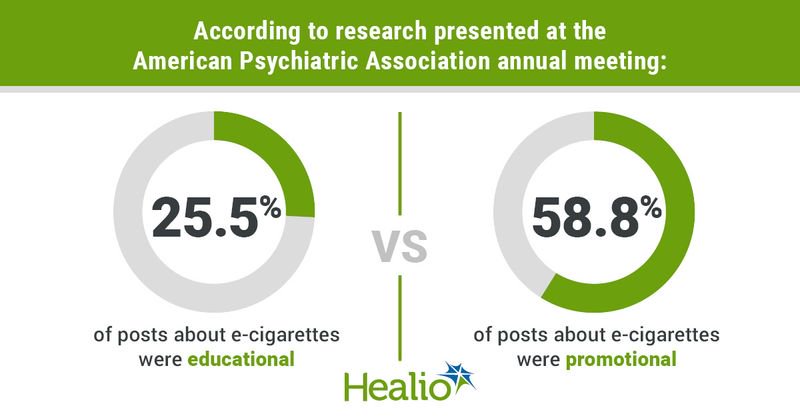E-cigarette content regulations not adequately enforced on social media
Key takeaways:
- E-cigarettes were positively depicted in 66.7% of Instagram posts and negatively depicted in 23.5%.
- Engagement with e-cigarette content is relatively high at 4%.
NEW YORK — FDA regulations and Instagram content policies designed to minimize youth exposure to content promoting electronic nicotine delivery systems are not well enforced, according to recent research.
“E-cigarettes are the most commonly used tobacco product among high schoolers and middle schoolers,” Jessica T. Tran, BS, from the University of Texas Medical Branch John Sealy School of Medicine, told Healio at the American Psychiatric Association annual meeting. “They are also extensively promoted on visual-based social media platforms such as Instagram, TikTok and Snapchat. Previous studies have found that youth exposure to media content is associated with increased usage of e-cigarettes and vaping products.”

Tran and colleagues queried Instagram posts from September to December 2023 using the profile of a 14-year-old girl in an incognito web browser with popular hashtags like #vaping, #vapelife and #ejuice.

After selecting the top 27 publicly available posts from each hashtag, two reviewers assessed each post for accuracy of information, presence of health-related warnings, depiction of e-cigarette use and common themes.
The researchers found that 51% of the posts were reels, 9.8% were memes, and 39.2% were images. Influencer accounts were responsible for 41.2% of the posts, and 25.5% were commercial.
Electronic nicotine delivery systems were positively depicted in 66.7% of the posts, negatively depicted in 23.5% and neutrally depicted in 9.8%. Posts that depicted e-cigarettes positively were more likely to use visual appeals, while posts that depicted e-cigarettes negatively were more likely to use emotional appeal. Those that portrayed e-cigarettes naturally were most likely to employ humor.
“We found that, on average, engagement with this type of content was around 4.7% engagement rate, which is, according to social media experts, relatively high. Engagement rate of 1% to 5% is considered good,” Tran said. “That is an industry that we can tap into with more public health messaging and educational content about the harms of vaping.”
Only 25.5% of the posts were educational, while 58.8% were promotional.
Despite FDA regulations requiring warnings regarding age restrictions or the addictive potential of nicotine, two-thirds of the posts contained no warning, and nearly half of the posts were shared by vape ambassadors, reviewers or shops, in violation of Instagram’s policy.
“We know that youth eyeballs will be on Instagram, TikTok, YouTube.” Howard Liu, MD, MBA, chair of the University of Nebraska Medical Center Department of Psychiatry and chair of the APA’s Council on Communications, said at an APA-sponsored press conference. “It’s important for us as a health care organization to be sure we’re on those platforms and spreading information on those platforms. We need to make sure we’re part of that dialogue.”
Reference:
- New Research: E-Cigarette Content on Instagram Violates Policies, Is Marketed to Teens. https://www.psychiatry.org/news-room/news-releases/new-research-e-cig-content-on-instagram. Published May 4, 2024. Accessed May 5, 2024.

